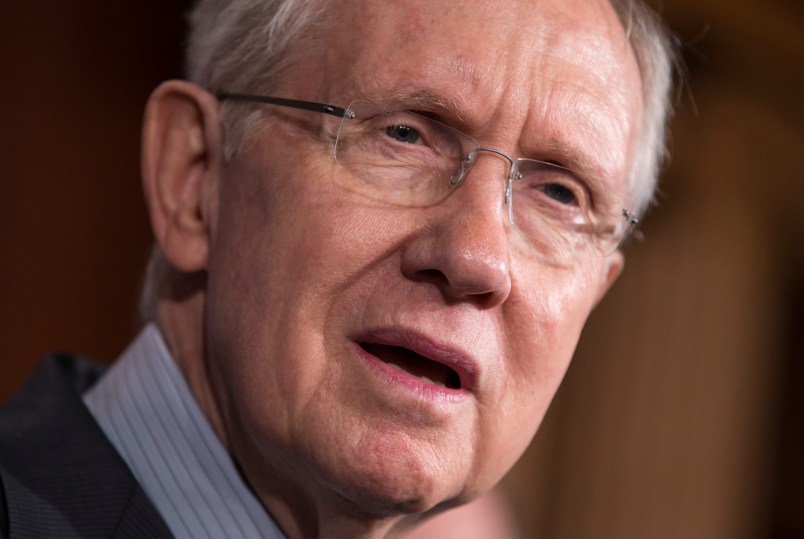Senate Majority Leader Harry Reid scheduled a climactic vote for Thursday on the nomination of attorney Patricia Millett to the Washington D.C. Circuit Court of Appeals, who Republicans have opposed for months. They have no particular objection to Millett — they objected to all three of President Obama’s nominees to the court. The opposition was enough to make the administration withdraw Caitlin Halligan’s nomination in March.
The vote Reid scheduled this week may be filibustered, and Reid has signaled — for the third time in 2013 — he may “go nuclear” and change the Senate rules to remove the 60-vote barrier to judicial nominations. (Technically, nominees only need a majority to be confirmed, but the Senate needs 60 senators to “file cloture,” or agree to move forward with the vote.) Backers of such a change argue that obstruction and delay in the judicial nomination process is worse than ever. Are they right?
Back in 2002, long delays in the Senate confirmation of federal judges so alarmed then-Supreme Court Chief Justice William Rehnquist that he called upon the President and Congress to “work together to fix the underlying problems that have bogged down the nomination and confirmation process for so many years.” The confirmation process has hardly gotten smoother since then.
Who is responsible for so much obstruction and delay? Republicans and Democrats point at each other. To offer a more comprehensive and objective picture, I developed an Index of Obstruction and Delay and used it to track trends under all presidents since Jimmy Carter in the late 1970s.
Here’s how the Index works: Individual Congresses hold sessions over two years. For instance, the 95th Congress was in session during 1977 and 1978, the first two years of Jimmy Carter’s presidency, and the 111th Congress held office in 2009 and 2010, during the first two years of Barack Obama’s presidency. For each two-year Congress, my index measures obstruction and delay in combination.
“Obstruction” occurs when no action is taken to either confirm or deny a presidential nomination, and “delay” occurs when it takes more than 180 days from the date of nomination to a confirmation vote. I track only nominations to basic district courts and to federal appellate courts other than the D.C.-based Federal Circuit and the local D.C. Court of Appeals (not to be confused with the U.S. Court of Appeals for the District of Columbia Circuit, the court whose nominees are currently in contention).
The Index equals the number of nominees who remain unconfirmed at the end of the Congress plus the number for whom the confirmation process took in excess of 180 days, with the total divided by the total number of nominees the president submitted to that two-year Congress. The Index ranges from 0.0000, indicating a complete absence of any obstruction or delay, to 1.0000, indicating full obstruction and delay. To makes sure there was sufficient time for the Senate to act, I set aside nominations made after July 1 of the second session of each Congress.
With such a measuring tool, it is easy to track trends over many Congresses dealing with nominations from both Democratic and Republican presidents. Here’s the chart:

Through my analysis, some straightforward findings quickly became apparent:
- No matter which party controlled the presidency or the Senate, not much obstruction and delay happened before President Ronald Reagan’s last two years in office, 1987-88.
- Partisan obstruction and delay in the confirmation of lower court judges gained steam when Senate Democrats objected to several Reagan nominees and ramped up during the presidencies of Republican George H.W. Bush and (especially) Democrat Bill Clinton and Republican George W. Bush. Under the latter, minority Democrats filibustered.
- After Obama took office in 2009, the Republican Senate minority not only obstructed nominees they found ideologically extreme, but routinely delayed or blocked all votes.
- Relatively more Senate foot dragging happens on nominees to federal judgeships in the second half of four-year presidential terms, just before another presidential election. If this trend continues, President Obama can expect even more obstruction in 2015 and 2016.
My Index confirms that minority obstruction and delay has, in fact, reached unprecedented levels under Obama. Democratic minorities may have started it, but partisan obstruction and delay are more rampant than ever today.
Sheldon Goldman is Distinguished Professor of Political Science, University of Massachusetts Amherst and a member of the Scholars Strategy Network. He is author of “Picking Federal Judges: Lower Court Selection from Roosevelt Through Reagan” published by Yale University Press.






